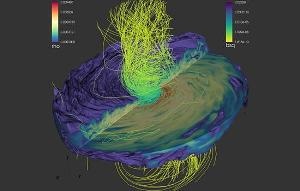Feb 16 2018
According to scientists from the Rochester Institute of Technology (RIT), an innovative simulation of supermassive black holes, which are the leviathans at the center of all galaxies, adopts a realistic setting to estimate the light signals emitted into the surrounding gas before the collision of the masses.
 Magnetic field lines emanate from a pair of supermassive black holes nearing merger within a large gas disk in a simulation by RIT scientists. Periodic light signals in the gas disk could someday help scientists locate supermassive binary black holes. (Image credit: RIT Center for Computational Relativity and Gravitation)
Magnetic field lines emanate from a pair of supermassive black holes nearing merger within a large gas disk in a simulation by RIT scientists. Periodic light signals in the gas disk could someday help scientists locate supermassive binary black holes. (Image credit: RIT Center for Computational Relativity and Gravitation)
The research headed by RIT is the initial step in estimating the ensuing fusion of supermassive black holes by adopting the two channels of information now at the disposal of researchers—the gravitational and the electromagnetic wave spectra—called the multimessenger astrophysics. The outcomes of the study have been reported in a paper titled “Quasi-periodic Behavior of Mini-disks in Binary Black Holes Approaching Merger,” published in the journal Astrophysical Journal Letters.
“We’ve performed the first simulation in which an accretion disk around a binary black hole feeds individual accretion disks, or mini-disks, around each black hole in general relativity and magnetohydrodynamics,” stated Dennis Bowen, lead author of the study, who is a postdoctoral researcher at RIT’s Center for Computational Relativity and Gravitation.
In contrast to their less massive counterparts, first observed in the year 2016, supermassive black holes are fueled by gas disks surrounding them similar to doughnuts. The powerful gravitational attraction between the black holes inspiraling toward each other heats and disturb the gas flow from the disk to the black hole and release periodic signals in the visible to X-ray portions of the electromagnetic spectrum.
“We have not yet seen two supermassive black holes get this close,” stated Bowen. “It provides the first hints of what these mergers will look like in a telescope. The filling and refilling of mini-disks affect the light signatures.”
The simulation patterns the supermassive black holes into a binary pair, where each black hole is encircled by its gas disks. A considerably huge gas disk surrounds the black holes and disproportionately fuels one mini-disk over another, resulting in the filling-and-refilling cycle reported in the paper.
“The evolution is long enough to study what the real science outcome would look like,” stated Manuela Campanelli, one of the co-authors of the paper, who is director of the Center for Computational Relativity and Gravitation.
Binary supermassive black holes release gravitational waves at very low frequencies when compared to stellar-mass black holes. In 2016, the ground-based Laser Interferometer Gravitational-wave Observatory (LIGO), observed the first gravitational waves from a collision of stellar mass black holes by using an instrument adjusted to higher frequencies. LIGO’s sensitivity is not adequate to detect the gravitational wave signals generated by the coalescence of supermassive black holes.
The space-based Laser Interferometer Space Antenna (LISA), planned to go operational by the 2030s, will observe gravitational waves from the collision of supermassive black holes in the cosmos. Upon getting functional in the 2020s, the ground-based Large Synoptic Survey Telescope (LSST), which is being constructed in Cerro Pachón, Chile, will enable the broadest and the most in-depth detection of light emissions in the universe. The signal pattern estimated in the RIT study could lead researchers to find orbiting supermassive black holes pairs.
“In the era of multimessenger astrophysics, simulations such as this are necessary to make direct predictions of electromagnetic signals that will accompany gravitational waves,” stated Bowen. “This is the first step toward the ultimate goal of simulations capable of making direct predictions of the electromagnetic signal from binary black holes approaching merger.”
Bowen and his team integrated simulations from RIT’s Black Hole Lab computer clusters and the Blue Waters supercomputer at the National Center for Supercomputing Applications at the University of Illinois at Urbana-Champaign, one of the largest supercomputers in the United States.
Astrophysicists from RIT, Johns Hopkins University, and NASA’s Goddard Space Flight Center work in partnership on the project. The paper is based on the Ph.D. dissertation of Bowen at RIT and concludes the study started by Scott Noble, one of the co-authors who is a former RIT post-doctoral researcher, who is at present working at NASA’s Goddard Space Flight Center. Their study is part of a joint National Science Foundation-funded research headed by Campanelli. RIT postdoctoral researcher Vassilios Mewes; former RIT post-doctoral researcher Miguel Zilhao who is now working at Universidade de Lisboa, Portugal; and Julian Krolik, professor of physics and astronomy at Johns Hopkins University are the other co-authors of the study.
In a forthcoming paper, the researchers will further investigate the link between gas flowing in and out of the accretion disks and variations in the emission of light. They will exhibit estimations of light signatures that scientists can anticipate to observe with state-of-the-art telescopes when searching for supermassive black holes nearing fusion.
RIT density contours